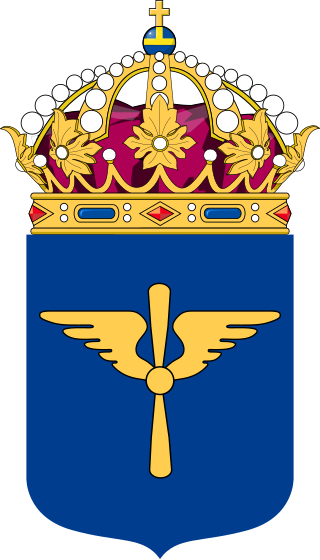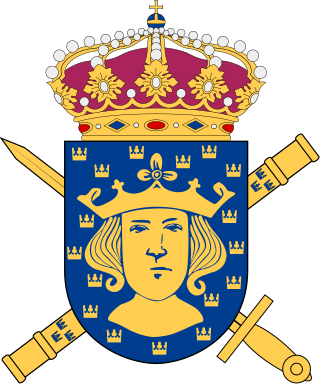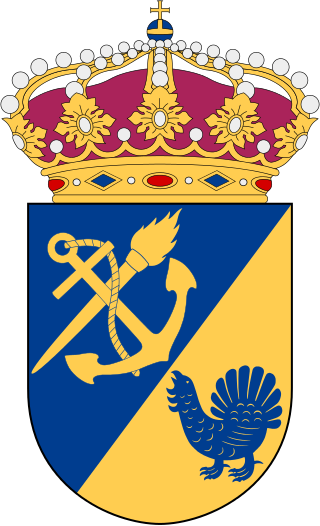
The Chief of Defence, formerly the Supreme Commander of the Swedish Armed Forces is the highest ranked professional military officer in the Swedish Armed Forces, and is by NATO terminology the Swedish chief of defence equivalent. The Chief of Defence is the agency head of the Swedish Armed Forces and formally reports to the Government of Sweden, though normally through the Minister for Defence. The primary responsibilities and duties of the Chief of Defence are prescribed in an ordinance issued by the Government.

The Chief of Army is the most senior appointment in the Swedish Army. The position Chief of Army was introduced in 1937 and the current form in 2014.

Air Staff is the staff of the Chief of the Swedish Air Force. It was officially established in 1936 due to the Defence Act of 1936 and would handle matters of a general nature. The Air Staff's duties included, among other things, assisting the Chief of the Air Force with the leadership of the Air Force's mobilization, training, tactics, organization, equipment, and personnel to the extent that such activity was not directly related to operational activities, which the Defence Staff then handled. In 1994, the Swedish Armed Forces Headquarters took over the Air Staff's duties. In 2019, the Air Force Staff was re-established in Uppsala Garrison.

The Chief of Navy is the most senior appointment in the Swedish Navy. The position Chief of Navy was introduced in 1936 and the current form in 2014.

Army Staff is the staff of the Chief of the Swedish Army. It was originally established in 1937. The Army Staff's duties then included, among other things to assist the Chief of the Army with leadership of the Army's mobilization, training, tactics, organization, equipment and personnel to the extent that such activity was not directly related to operational activities, which was handled by the Defence Staff. In 1994 the Swedish Armed Forces Headquarters took over the Army Staff's duties. In 2019, the Army Staff was re-established, now located in Enköping Garrison.

Admiral Stig (Hansson) H:son Ericson was a Swedish Navy naval officer. He was Commander-in-Chief of the Coastal Fleet from 1950 to 1953 and the Chief of the Navy from 1953 to 1961. After retiring from the Navy in 1961, Ericson held court offices in the Royal Court of Sweden. He was First Marshal of the Court from 1962 to 1973 and Marshal of the Realm from 1966 to 1976.

The Eastern Army Division, was a division of the Swedish Army that operated in various forms from 1941 to 2000. Its staff was located in Strängnäs Garrison in Strängnäs. The unit was disbanded as a result of the disarmament policies set forward in the Defence Act of 2000.

The Middle Army Division, was a division of the Swedish Army which operated in various forms from 1941 to 1997. Its staff was located in Linköping Garrison in Linköping.

Maritime Component Command was a part of the Joint Forces Command of the Swedish Armed Forces. The staff was located at the Swedish Armed Forces Headquarters in Stockholm and is headed by the Chief of Navy. The Maritime Component Command commanded the operations of the Swedish Navy forces.

The Surgeon-General of the Swedish Armed Forces is the highest-ranking medical officer of the Swedish Armed Forces. The Surgeon-General is responsible for the supervision of the Swedish Armed Forces, the Defence Materiel Administration, the Swedish Fortifications Agency and the National Defence Radio Establishment. This includes supervision in the areas of environment, health, nature, sewage, waste and chemicals.

The Commandant General in Stockholm is a military position in Sweden with responsibility for state ceremonial activities. Lieutenant General Carl-Johan Edström, Chief of Defence Staff is the Commandant General in Stockholm since 1 October 2024.

The Air Component Command was a part of the Joint Forces Command of the Swedish Armed Forces. The staff was located at the Swedish Armed Forces Headquarters in Stockholm. The Air Component Command commanded the operations of the Swedish Air Force.

The Medical Corps of the Swedish Armed Forces was a joint administrative corps for military physicians and military veterinarians in the Swedish Armed Forces. It was formed in 1969 by merging the Swedish Army Medical Corps, the Swedish Naval Medical Officers’ Corps and the Swedish Army Veterinary Corps. Its head was the Surgeon-General of the Swedish Armed Forces and was subordinate to the Supreme Commander of the Swedish Armed Forces. The Surgeon-General had at his disposal a staff body, the medical corps office, which was organizationally part of the National Swedish Board of Health (Sjukvårdsstyrelsen). Under the National Swedish Board of Health, the responsibility for the Swedish Armed Forces's health care lied with the military commander.

The Swedish Armed Forces Headquarters is the highest level of command in the Swedish Armed Forces. Established in 1994, its primary task is to command operations, but is also involved in areas such as military strategy, the overall development of the Swedish Armed Forces, and acting as a channel of contact with government. It's located at Lidingövägen 24 at Gärdet in Stockholm.

Berga Naval Training Schools was a military branch school for the Swedish Fleet within the Swedish Navy, which operated in various forms from 1946 to 1997. The staff was located at Berga Naval Base in Haninge Garrison in Berga, Haninge Municipality.

The Chief of the Defence Staff is the second most senior uniformed member of the Swedish Armed Forces and heads the Defence Staff. The Chief of the Defence Staff reports to the Chief of Defence and serves as their chief of staff.

The Chief of the Naval Staff is the professional head of the Swedish Naval Staff. The post was created in 1907 with rear admiral Theodor Sandström as the first incumbent. The post disappeared in 1994 and was reintroduced in 2019 when the new Naval Staff was established.
Vice admiral is a three-star commissioned naval officer rank in the Swedish Navy. Vice admiral ranks above rear admiral and below admiral. Vice admiral is equivalent to the rank of lieutenant general.
The Surgeon-in-Chief of the Swedish Army was from 1943 to 1969 the senior-most officer and head of the Swedish Army Medical Corps.
The Surgeon-in-Chief of the Swedish Navy was from 1902 to 1969 the senior-most officer and head of the Swedish Naval Medical Officers' Corps, responsible for naval surgeons and the overall medical care in the Swedish Navy and the Swedish Coastal Artillery. The Surgeon-in-Chief was posted to the Naval Staff and reported to the Chief of the Navy.

















